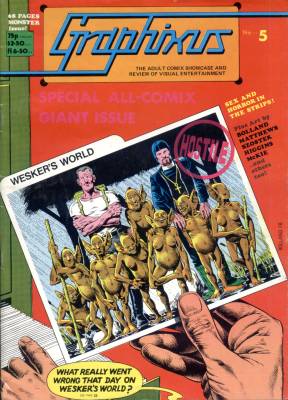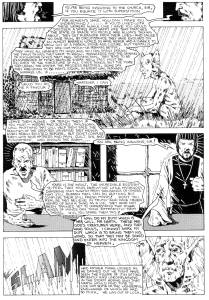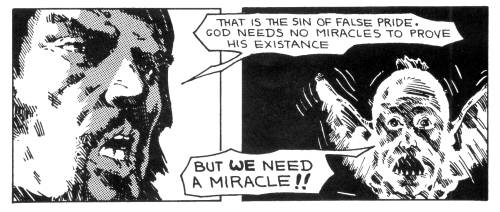 Adapted from Harry Harrison's short story "The
Streets of Ashkelon" (vt. "An Alien Agony"), written and drawn by
Brian Bolland.
Adapted from Harry Harrison's short story "The
Streets of Ashkelon" (vt. "An Alien Agony"), written and drawn by
Brian Bolland.
Graphixus was a British-produced large format (A4 size) comics magazine published in the late 1970s. It featured articles, interviews, reviews and news, and a lot of comic strips - many of which were less than a page in length.
The magazine was subtitled "The Adult Comix Showcase and Review of Visual Entertainment". Many of the writers and artists featured in Graphixus went on to become big names in the industry, notably John Higgins, Angus McKie, Bryan Talbot, Garry Leach, Richard Burton and Nick Landau.
Bolland's adaptation of "The Streets of Askhelon" is one of the longer strips to be published in the magazine: it occupies 10 pages of issue #5 (August - September 1978), as well as getting the cover spot (reproduced on the right).
While the cover of Graphixus is "classic" Bolland work (very fine line art, nice dark shadows, realistic figures), the interior artwork is not his best. It seems sketchy at times, almost rushed. I'd be tempted to suggest that this was one of his first works, if not for Bolland's superbly drawn Forbidden Planet advert in the same issue.
 The adaptation of Harry's story is pretty close to the original, the only
notable exception being the name of the lead character - Garth has become
John Narth, for some reason. The important points are all there: the arrival
on Wesker's World of Father Mark, his conflict with "Narth", the building of
the church and the villagers' attempts to understand Christianity. Plus, of
course, the denoument.
The adaptation of Harry's story is pretty close to the original, the only
notable exception being the name of the lead character - Garth has become
John Narth, for some reason. The important points are all there: the arrival
on Wesker's World of Father Mark, his conflict with "Narth", the building of
the church and the villagers' attempts to understand Christianity. Plus, of
course, the denoument.
This is a very dialogue-heavy adaptation. That's necessary to get the full flavour of the story across, but it does slow things down a lot. The fifth page (right, in which Narth and Father Mark discuss their differing philosphies) is crammed with huge speech bubbles, while the ninth page is comparatively devoid of dialogue.
Interestingly, towards the end of the story Bolland's art improves. The first panel reproduced below shows the seeds of the style with which he later became synonymous: realistic, emotive, and detailled. Unfortunately, the second panel below is more indicative of the style for this story...

Around the time this issue was published, Bolland began working on 2000 AD, where he came to fame drawing Judge Dredd. Though he hasn't drawn Dredd for years, many fans still consider Bolland to be the definitive Judge Dredd artist.
He has a reputation for producing some of the best artwork the comics industry has ever seen. He's won countless awards and is considered by his peers to be among the best in the business.
In the past decade or so, Bolland's output has been rather low, mainly covers for DC Comics.
Other notable works include The Killing Joke (a Batman short graphic novel written by Alan Moore and coloured by John Higgins) and Camelot 3000 (a twelve-part "updating" of the Arthurian legend, co-created by Bolland with author Mike W. Barr).